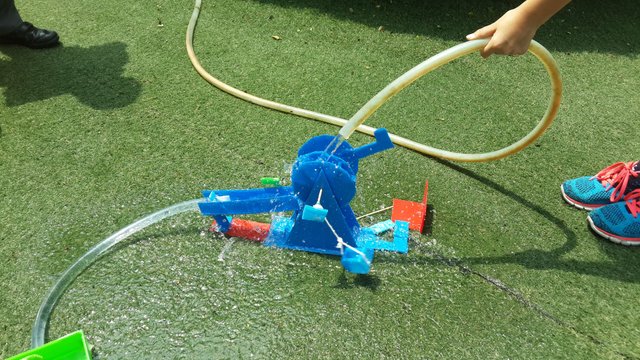Waterwheels and water management systems. Kids school project.
For those of you that have visited or lived in Bangkok during the rainy season, you will know that the city floods easily. As part of a 'Water Cycle' topic in my Year 3 Humanities class we addressed the problem of water management.
Electric waterwheels can been seen throughout Thailand, usually used to oxygenate stagnant water or encourage water flow. Out towards mountainous areas where water flows at different heights, simple water wheels can still be found producing power for small village communities and changing and redirecting water along bamboo aqueducts.
The students were given the task to design and build their own waterwheel system. The only source of energy was the weight of water to turn the first wheel.

Students had already watch videos and seen real wheels/turbines used in real life. They understood that irrigation allows for the moment of water from a wet place to a dry place and how aqueducts can assist with this. They had multiple ideas and some children even tried to combine different systems.
.png)
Apart from having one wheel that just turned, the class were encouraged to design a system that would power another part to prove energy can be shared or transferred to other objects.
.png)
.png)
Some students built waterwheels that acted as cogs. As the first wheel turned, the teeth would force the next wheel to turn.. and so on. Another design used string and followed the basic principal of bicycle peddles and a chain.
Long 'hammer' arms were attached to the axle of a chosen wheel. As the wheel turned, the hammer would spin round and smash 'something'. This design came directly from old farming machines to crush grain.
.png)
The waterwheel systems were all tested outside with the hose pipe. The students had to first explain to the class how they intended the system to work and its use. Points were awarded not only for the success of their wheel, but how they presented their ideas, their understanding of water systems, having a functional use and being able to identify the faults it may have had during testing and how to improve them.

In the photo above you can see a hammer and winch system have been incorporated into the same design.
All material used were waterproof for obvious reasons. Hot glue held the parts in place and corrugated feature/future board allowed for a strong structure.
.png)
The students were given responsibility on how the tests should be carried out and at which point the hose pipe should be held.
.png)
The students were all very proud of their work and eager to take them home for another test and demonstration for their families.
.png)
.png)
In conclusion to this experiment, the students were able to offer a range of ideas and solutions in tackling Bangkok's drainage problem in the rainy season and water shortage problem in the dry season. The practicality and potential financial costs were of course ignored, but their ideas were certainly imaginative!
If you liked this post, please don't forget to follow and upvote for more :)
i want to back my childhood. i miss a lot those day. specially i miss my father. now he is no more
I hope you have many happy memories :)
same drainage system problem in Mumbai (India). Good idea solve the water shortage and drainage system.
Yes there are many cities like this from around the world. Thanks for your comment
Excellent. Thank you, glad you saw it :)
Great little project @thinkit, have you had a chance to get out on your motorbike recently?
Not yet, too busy at work and rains every time im free!
Great little project @thinkit, have you had a chance to get out on your motorbike recently?